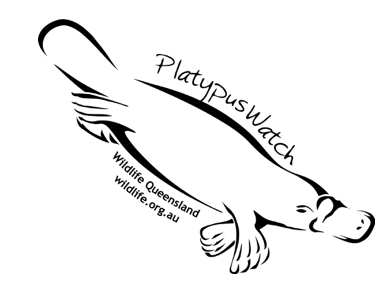The Platypus is one of the Australia’s most remarkable and elusive animals.
Since 2008, we have been actively surveying these iconic animals to uncover critical information about Platypus population, distribution and health in South-East Queensland.
The Platypus is a uniquely Australian animal, once found in abundance in freshwater streams and rivers along the east coast.
However, increasing pressures from urbanisation and pollution threaten the habitat and survival of our wild Platypus populations. In South-East Queensland, we are facing some of the highest urbanisation rates in the country.
Much about their life cycle in the wild remains a mystery, and understanding their behavior, distribution, and abundance is crucial for effective conservation.
This is where PlatypusWatch comes in.

The Platypus
The Platypus (Ornithorhynchus anatinus) is easily recognizable with its webbed feet, duck-like bill, and sleek coat.
Found in the waterways of Eastern Australia, Platypuses are monotremes; one of only two egg-laying mammals in Australia.
These elusive, solitary creatures are most active from dusk to dawn, when they primarily feed on bottom-dwelling invertebrates but also frogs, fish, or insects at the water’s surface. They spend their days sheltering in burrows dug into stream banks.
Much of our understanding of Platypus comes from southern populations.
However, changes in behaviour can influence how we need to manage these animals. We are working to understand more about northern Platypus, so we can better protect local populations.
Seasonal surveys
Surveying begins at dawn, with dedicated PlatypusWatch volunteers stationed at observation sites along the survey catchments.
Equipped with binoculars and a keen sense of observation, volunteers meticulously document sightings and behaviors of platypuses, noting activity patterns, physical condition, and interactions with their environment.
Watergum conducts comprehensive surveys twice annually, in spring and autumn, corresponding to the juvenile and mating periods of platypuses.
These surveys are crucial for monitoring changes in Platypus distribution, providing valuable data on population health and detecting shifts due to environmental factors or human impact. The information gathered supports targeted conservation efforts and informs strategies to protect and restore habitats.


Platypus365
Since 2023, Watergum has been coordinating daily surveys at our Coomera River site.
Much of our current understanding of platypuses is based on studies of southern populations, but this groundbreaking project is revealing new information about the seasonal behaviors and ecological needs of platypuses in South-East Queensland.
Platy365 gathers continuous, detailed data that sheds light on the local platypus population’s habits, movements, and responses to environmental changes.
This is crucial for developing targeted conservation strategies tailored to the unique conditions of this region.
Uncovering insights
With increasing threats to Platypus, including climate change, invasive species and urbanisation, it is now more important then ever to protect our native wildlife.
Understanding how population and distribution patterns are being impacted by these threats is crucial in safeguarding the future survival of our native species.
So far, our platypus surveys have uncovered where Platypus populations are stable or declining. Through Year 1 of Platy365, we have learned about variation in breeding seasonality in our northern populations.
As we move forward, we hope to continue expanding our survey efforts and deepening our understanding of local platypus distributions; fighting for healthy habitats and populations for years to come!

Get involved!
Help protect and conserve one of Australia’s most unique creatures! Whether you join our seasonal surveys, take part in Platy365 or sponsor a stream, every contribution makes a difference.
Together, we can ensure a future for Platypus in our local waterways.
Complete your induction
Check our calendar of events to find an upcoming PlatypusWatch induction. Alternatively, complete out online PlatypusWatch induction here.
Submit your data
Have you been out surveying? Submit your data to our citizen science database and make a difference.
See our outcomes
We make sure our data makes a difference. Check out our PlatypusWatch outcomes from past years.
PlatypusWatch recieves funding and support from


Proudly working in partnership with



Want to learn more about how we are protecting our iconic wildlife?